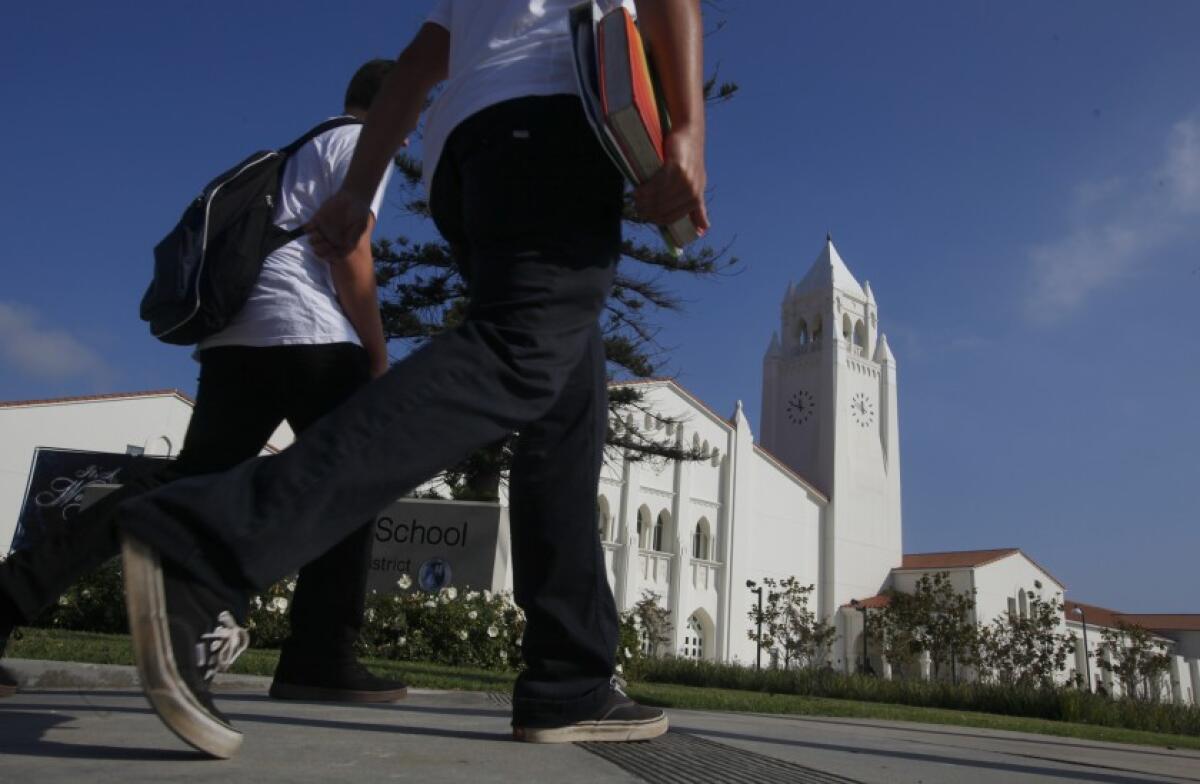Apodaca: New state bill would address one aspect of unfairness in public school funding

- Share via
Very little about the way we fund public education has ever made much sense to me. Unfairness and inequality are essentially baked into the system.
But there’s one aspect of the way that California finances K-12 education that has always seemed particularly nonsensical: Money from the state is doled out to schools according to attendance figures, rather than basing the allocations on the number of students actually enrolled.
At first glance, this might not seem like a big difference. But the practical effect has been to exacerbate inequities and hurt the students in low-income areas that are most in need of support from the state.
How can it ever make sense to rob schools of money when the reason for their high rates of absenteeism is that many of their students face disproportionate effects of poverty, ill health, housing insecurity, hunger and other issues that make showing up for class a daily challenge?
Now state Senate Bill 830, introduced by state Sen. Anthony Portantino (D-La Cañada Flintridge), seeks to remedy this bad policy.
The legislation would base school funding on the number of students enrolled instead of on daily attendance. If the bill passes, it would bring California into conformity with the vast majority of other states.
This change wouldn’t impact so-called “basic aid” school districts, which are generally in wealthier areas that are not reliant on state funds because they raise enough money through local property taxes to pay for their schools. Newport-Mesa Unified and Laguna Beach, for example, are both basic aid districts.
But even constituents in those districts should support, if not this specific legislation, at least some measure with similar intent. Making the lopsided public school financing structure more balanced and fair would benefit all of society by nudging the scales, if only a little bit, back toward those students who attend schools so starved for funds that they often lack the most basic pieces of a sound education.
Student conduct at county campuses reflects a broader need for education about the experiences of various cultures, writes Daily Pilot contributor Patrice Apodaca.
Even the most cursory examinations of the differences can reveal some harsh realities. Features that are taken for granted in more affluent areas — a wide variety of course offerings, nurses, counselors, libraries, field trips, working technology, just to name just a few — are often scarce at poorer schools. Instead the broken desks and toilets that haven’t worked in years stand as depressing testimony to the ways we are failing some of the most vulnerable kids.
The bill would also require that at least half of the funding increases that some schools stand to get be spent on antitruancy measures.
It’s important to note that this proposed change is occurring against a backdrop of declining enrollment throughout the state for the past several years — largely due to lower birth rates — and the excruciating challenges schools have faced during the COVID-19 pandemic. As the number of school-age children continues to trend downward, and high rates of absenteeism persist amid COVID concerns, schools will remain under enormous pressure to adapt in an environment even more fraught than usual.
Some ideas to ease the burden have been floated.
Because enrollment, already in decline, fell off a cliff during the pandemic, Gov. Gavin Newsom has proposed giving districts the choice of having their funding based on a three-year average of daily attendance rates. This is intended to lessen the cuts they would experience in the next school year after the policy that granted temporary relief from attendance-based funding during the pandemic expires.
Such temporary fixes aside, both chronic absenteeism and declining enrollment are trends that will likely prompt the state to consider a larger reevaluation of education funding in the years to come. Exactly how that will play out is anyone’s guess.
For now, some see the state’s current budget surplus as an opportunity to provide additional support for low-income schools.
Newsom’s proposed budget for next year, revealed last month, would boost overall education spending. He also proposed accelerating funding for several programs, including the Expanded Learning Opportunity Program, which will provide a nine-hour school day with before-school and after-school programs for low-income children through sixth grade and the biggest appropriation in decades for arts and music programs.
The proposed budget also includes additional funds over five years for high-needs schools to train and hire literacy coaches and reading specialists and to offer individual and small group help for struggling readers. New one-time grants would create or expand multilingual schools or classroom libraries to support reading instruction.
These are all worthy investments. Yet sometimes I can’t stop myself from daydreaming about tearing down our entire public education infrastructure and the wacky way we finance it, and starting again from scratch. We could build something that would finally deliver on the promise of equal opportunity for all.
It’s an interesting thought experiment laced with a heaping dose of wishful thinking that we’re capable of such revolutionary, high-minded change. For now, it’s at least encouraging that we continue to look for ways to offset the monumental inequality that’s a built-in feature of the flawed system we’re stuck with.
These latest proposals might not be the best of all solutions. But they’re probably the best we’re going to get.
All the latest on Orange County from Orange County.
Get our free TimesOC newsletter.
You may occasionally receive promotional content from the Daily Pilot.







